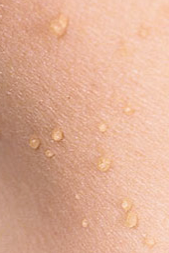
Freezing skin tags off with liquid nitrogen, known as cryosurgery or cryotherapy, is a common method of removing skin tags. Cryosurgery is also used to remove warts and other benign (non-cancerous) skin growths. The procedure is usually performed in a doctor’s office. If you’re considering having a skin tag frozen off, or if you’re wondering about your options for removing skin tags, we’ll tell you all about cryosurgery and about some other methods of removing these skin growths.
Why Freeze Skin Tags Off?
Most of the time it is not medically necessary to remove a skin tag. People often prefer to remove them, though, especially if they are in a highly visible place like on the face or neck. In some cases, skin tags even begin to affect a person’s self-esteem. People may feel self-conscious about their appearance and withdraw from social activities because of skin tags.
Sometimes skin tags catch on clothing or jewelry and or simply rub against skin folds, which may irritate the skin or cause pain or even bleeding. If that happens, doctors often recommend removing skin tags in order to prevent inflammation, discomfort, and bleeding.
Cryosurgery is not the only way to remove skin tags, but it’s a method frequently used by doctors because it’s quick, can be done in a doctor’s office, usually only takes one treatment, and is considered a fairly safe, routine procedure. If you have questions about your options or about the best choice for you, talk to your doctor.
How Do You Freeze Skin Tags Off?
Doctors use liquid nitrogen, which is extremely cold, to freeze off skin tags. Liquid nitrogen will freeze and kill any living tissue it comes into contact within just seconds. It is usually applied to skin tags with a swab. It must be applied carefully because it will kill any surrounding tissue it comes into contact with as well as the skin tag.
Freezing off a skin tag with liquid nitrogen feels similar to holding an ice cube against your skin for 10 to 30 seconds, only colder. That’s how long the liquid nitrogen is applied to the skin tag. Your doctor may numb the area with a local anesthetic first.
Afterward, your doctor will probably apply a bandage to the area. Your doctor will also give you instructions on how to care for the treated area at home.

Risks Involved With Freezing Skin Tags Off
Freezing off skin tags is generally considered to be a pretty safe procedure, though complications can occur in some instances. There is usually some discomfort during the procedure. Afterward, the skin may be red, irritated, or inflamed, resembling a burn. A blister may form. Less commonly, the infection may occur.
Cryosurgery must be done by a doctor, of course. Your primary care physician may not be able to do it but may refer you to a specialist called a dermatologist for the procedure.
You should also be aware that cryosurgery for skin tags may not be covered by your health insurance if the procedure is not medically necessary but simply cosmetic in nature. If you have to pay out of pocket, it may be pretty expensive. Make sure you understand your health insurance coverage and know how much you will need to pay if you have skin tags frozen off.
Alternatives to Freezing Skin Tags Off
Doctors might suggest cutting skin tags off or burning them off (known as electrocautery) instead of freezing them off. Those procedures carry similar risks as freezing off skin tags.
Some people prefer to use a natural method of removing skin tags rather than freeze skin tags off. Unfortunately, many of the natural methods or home remedies for removing skin tags are not very effective. Some are even dangerous. To learn more about natural remedies for skin tags, just follow the link.
Our Preferred Alternative to Freezing Skin Tags Off
Our preferred method of removing skin tags is a natural remedy called H-Skin Tags Formula. With homeopathic ingredients like Calendula officinalis and Thuja occidentalis and essential oils like tea tree oil, it removes skin tags gently and painlessly. It’s available without a prescription and is easy to use at home. It’s affordable and there is even a 90-day money-back guarantee if you aren’t satisfied with your results, so you have nothing to lose. To find out more about why this is our preferred treatment for skin tags and to read reviews from people that have used it, just follow the link.
